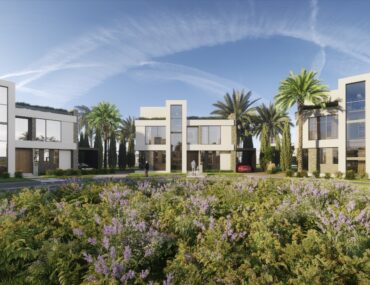The question of whether property prices in Egypt will start falling has become one of the most common topics among buyers, investors, and developers in 2025. With inflation, currency shifts, and rapid expansion across the real estate sector, many expected a correction. Yet, the numbers and the behaviour of the market tell a different story. Prices are not collapsing. They are, in most cases, still climbing, although at a slower pace in some segments.
Egypt’s property market is now more diverse than ever. It includes new cities with advanced infrastructure, mature neighbourhoods with strong resale markets, and coastal zones with international investment appeal. This variety means that there is no single trend across all categories. What we are seeing instead is selective growth. Some areas are peaking, others are stabilising, and a few are showing the first signs of maturity.
The short answer is that a sudden nationwide price drop is unlikely in the near term. What is happening is a shift in what drives value and how different parts of the market move at different speeds.
Why Prices Are Still High
Several factors explain why property prices in Egypt remain elevated despite economic challenges.
Cost is the first explanation. The cost of building supplies has increased. In recent years, there have been significant increases in steel, cement, finishing materials, and even transportation. In addition, labor costs have increased, and developers are paying more for imported goods like sanitary ware and electrical components as a result of global supply disruptions. The final prices of real estate reflect these increases.
Second, demand hasn’t changed. Egypt’s population is still increasing by over two million people annually, which means that housing is always needed. For many Egyptians, real estate remains the most secure investment option. Purchasing real estate feels more like a protective than a speculative move when inflation increases and currency values change. This way of thinking keeps prices stable and reduces the likelihood of a widespread drop.
Structure is the third factor. These days, developers are concentrating on integrated projects that combine commercial, residential, and recreational elements. These neighborhoods, which can be found in areas like west Cairo and New Cairo, the New Administrative Capital, are long-term developments with complete infrastructure in addition to being residences. Their quality of life, not just the price of the land, determines their value.
What May Slow Price Growth
Although the general trend is upward, some signs of slowing are visible in certain segments.
Moderation may be necessary for luxury properties in overcrowded areas, especially those that are remote from major cities or have inadequate infrastructure. Customers are now pickier. Many people are choosing smaller, more functional homes that are simpler to maintain and resell in place of larger villas. In response, developers are implementing smaller layouts and new payment plans to reflect the realities of the market.
The resale market is another possible source of pressure. Resale units depend on real demand, whereas new projects are priced based on growing construction costs. Homeowners may find fewer buyers if they attempt to sell at developer-level prices without adding value. Although prices will take longer to move, this does not necessarily imply that they will decrease.
Economic uncertainty also plays a role. As long as inflation remains high, financing options stay limited, and bank interest rates remain elevated, affordability will continue to challenge middle-income buyers. The market is therefore moving toward two directions: premium developments for high-end investors, and smaller, more flexible products for younger or first-time buyers.
The Impact of New Cities and Infrastructure
One of the strongest drivers of property performance today is urban expansion. Egypt’s new cities are redefining what buyers expect from housing. Areas such as New Cairo, Mostakbal City, Sheikh Zayed, and the New Administrative Capital have become the new centres of gravity.
The government has invested heavily in roads, schools, utilities, and transportation links, making these areas more functional and connected than ever before. Developers followed this momentum, creating compounds that offer services and community experiences. These features hold real, measurable value for residents and investors alike.
Properties in new cities may be more expensive to build, but they are also better protected against depreciation. Demand from young families, professionals, and returning expatriates ensures a steady flow of buyers. The trend suggests that price growth in well-serviced, planned environments will continue even if other parts of the market cool.
Older urban areas, by contrast, may stabilize. In some inner Cairo districts, infrastructure constraints and congestion make it difficult for values to rise at the same pace. Buyers in these neighbourhoods are often focused on lifestyle or proximity to work rather than capital appreciation. The result is a more balanced, slower-moving market.
The Coastal Equation
Egypt’s coastal properties have always followed a slightly different rhythm. The North Coast, the Red Sea, and emerging destinations such as Ras Sudr or Ain Sokhna operate in cycles influenced by tourism, holiday demand, and foreign currency inflows.
Currently, interest in coastal living is strong, but supply is also expanding. New mega-developments are entering the market with resort-style amenities, pushing competition higher. Prices in prime, fully-serviced projects remain strong, while secondary areas or incomplete resorts may face longer selling periods.
The good news for investors is that coastal demand is diversifying. Buyers are no longer focused only on summer homes. Many now view these areas as second residences or hybrid work destinations. That change creates more stable, year-round demand that helps support long-term price levels.
For Buyers and Investors
For anyone considering buying property in Egypt in 2025, the decision should depend less on timing and more on quality and purpose.
If the goal is long-term living, focus on infrastructure, accessibility, and the reputation of the developer. Projects with established services and maintenance systems will maintain value even in slower markets.
If the goal is investment, diversification matters. Mixing residential units in new urban centres with coastal or mixed-use properties spreads risk. Watching market delivery schedules and new project launches will help identify when temporary supply gluts may create opportunities to buy at better prices.
Buyers should also pay attention to how developers structure their payment plans. Extended instalment schedules have become standard, and they can offer flexibility, but they may also signal cash flow pressure from developers. Evaluating a project’s construction progress and delivery timeline is crucial before committing.
The Broader Economic Picture
The health of Egypt’s property market is closely linked to macroeconomic factors. Inflation, foreign investment flows, and interest rates all influence both developer strategy and buyer behaviour.
If inflation stabilises, the cost of construction may plateau, allowing prices to grow more moderately. However, if the currency weakens further or material costs continue to rise, developers will adjust pricing upward to protect margins.
Government initiatives, such as facilitating foreign ownership and expanding digital real estate registration, could also impact confidence. These steps make property transactions more transparent and potentially attract a broader pool of investors from abroad.
Overall, the market is behaving less like a speculative bubble and more like a maturing sector adapting to new realities. The shifts we are seeing are structural, not temporary corrections.
Outlook for 2025 and Beyond
Looking ahead, Egypt’s property prices are unlikely to fall in the short term. The combination of population growth, strong demand for modern housing, and continued construction costs keeps the market firm. Yet, the nature of growth is changing.
Instead of uniform appreciation, we are seeing segmentation. Prime new developments, integrated cities, and coastal destinations with complete infrastructure will likely continue rising. Older urban areas, luxury segments with limited end-user demand, or projects with delivery delays may level off or adjust slightly.
The result is a more selective market that rewards informed buyers. Those who focus on fundamentals, location, infrastructure, community, and quality will continue to see stability and potential appreciation. Those who buy purely on speculation or short-term hype may face slower returns.
The Final Picture
The Egyptian property market in 2025 is not heading toward a price crash. It is evolving. Prices remain high because of the structural drivers that support them.
However, the pattern of growth is becoming more sophisticated. There is no single market anymore. There are many sub-markets, each moving according to its own realities. For serious buyers, this is good news. It means the time of blind speculation is over and the time of informed decision-making has begun.
Prices are unlikely to fall soon, but opportunities will still exist for those who understand value, not just cost. Egypt’s real estate market is maturing into one defined by planning, performance, and long-term confidence rather than short-term noise.



